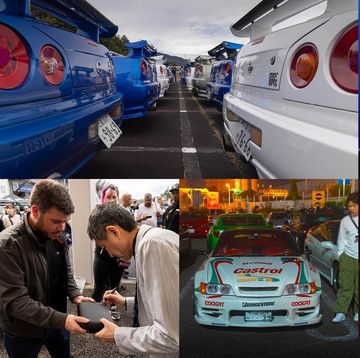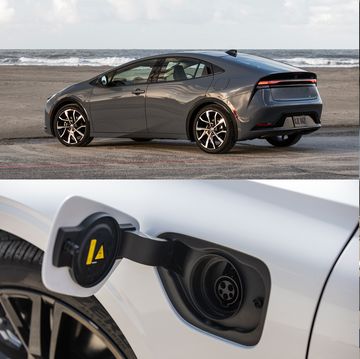We're in the Inner Sanctum. Nobody allowed. Only working Audi mechanics in team uniforms (and the occasional pulse-racing Yankee motoring journalist) get into the hyper-private F1 pit garages at Spa-Francorchamps. This is the heart of Belgium's Ardennes Forest, where the Battle of the Bulge raged in 1944. Today's battle involves the race car next to us, an Audi A4 gone berserk. You can't get your big toe under its leading edge. The roof comes up to your wallet. Under the hood is a race-prepped 4.0-liter V-8, and the carbon-fiber body is attached to a space-frame chassis that would make Jack Roush proud.
Inside this "sedan" is Danish master driver Tom Kristensen. Compact, trim, the very model of a modern motor racer, he's mashed down in the chassis halfway into the back seat. His helmet peeks over the doorsill. His head parallels the back door—and not because Kristensen has long legs. At five foot ten, he doesn't.
The racetrack out the door—Spa—is a forbidding prospect. It's not the gray skies and cool temperature. Or the constant threat of rain. Or the circuit's scary speeds. It's all these put together. Everywhere you look at Spa, a mistake is waiting to be made. Put another way, it's the ideal setting for a head-down, grab-ass DTM race. (That's "German Touring Car Championship" to you.) What's the DTM, and why do we care? It's sedan racing at its hottest. Winning in DTM means doing whatever it takes. The faint-hearted call it sport. The rest call it war.
But if you're a European pro and you have no ride in Formula 1 and there's no Le Mans Endurance Series race today, you have to be in DTM. It's like the cool banana bike you had to have when you were eight—imperative. The drivers come from all over Europe, some young and looking up at F1, some elderly and stepping down from F1. Most are journeymen who sincerely hate being in the middle. Beginning in 1984, DTM allowed virtually unregulated technology—and by 1996, it had collapsed under its sky-high costs.
But DTM was too hot to die. Revived in 2000, its new, NASCAR-like rules restrict everything from the transmissions to be used to the number of brake discs allowed per season. The DTM restrictor plate limits engines to about 470 horsepower. Depending on how well or poorly you're doing, ballast is added or subtracted in 20-kilogram increments. GM's Opel Division enters four Vectra GTS V-8s, Mercedes-Benz fields eight AMG C-classes, and Audi fields eight A4 DTMs. Seating is limited. Don't be late.
Which brings us back to Tom Kristensen. At 37, he is by his own admission long in the tooth. No problem. DTM welcomes a few select elders such as former world champion Mika Häkkinen, Jean Alesi, Rinaldo Capello, and Laurent Aiello. But other big names, lacking the thumb-in-the-eye aggressiveness necessary to succeed in DTM, are unceremoniously bounced out the series back door after one season, never to return.
Which is why Kristensen is fascinating. He is well past racer "middle age," but his brilliance is just now emerging. Last year was his first in DTM, and he hadn't debuted at Le Mans until 1997. That first time out, driving a Porsche GT1-97, he won the biggest prize in world endurance racing, overall victory at Le Mans. And finding he enjoyed the sensation of winning, he has driven Audi R8s—and one year a Bentley—to the overall Le Mans victory every year from 2000 to the present. Six in a row! That is 144 consecutive hours (shared with two co-drivers, of course) staying on the black, avoiding hazards (read "slow GT cars"), not flat-spotting the tires, and going like hell. Now with seven Le Mans victories, he has surpassed the great Jacky Ickx's record six wins. Winning Le Mans overall seven times in nine years is so completely off the scale—just fuhgedaboudit.
Audi R8s have been dominant in endurance racing since 2000, but Kristensen's win for Audi in 2005 was no slam-dunk. Year by year, Le Mans rules have imposed greater penalties on the Audi R8's speed, to give someone else (say, Frenchman Henri Pescarolo's fast prototypes) a leapfrog to victory. This year, the R8 engine-intake restrictor plate deleted 30 horsepower. In 2005, R8s carried 110 pounds of ballast, and their fuel-tank capacity was reduced by 2.6 gallons, requiring more stops. In 2000, the R8s reached 205 mph on the Mulsanne straight—this year, they could hit only 192. Kristensen and co-drivers Marco Werner and J.J. Lehto were able to qualify no better than eighth.
Yet by nightfall in the 24-hour race—Lehto complaining bitterly at the R8's reduced speed—Kristensen and friends were leading. Excellent fuel mileage allowed them 13 laps between stops, while the Pescarolo-Judd stopped every eight laps. In the end, Florida-based Champion Racing, Kristensen's two-Audi team, had its first Le Mans win. It was the first overall victory for an American team in 37 years.
"I may have more wins than Jacky Ickx," Kristensen said afterward, "but he is absolutely unique, a great personality—'Mr. Le Mans.' He called me before the race to wish me good luck, and now I can't wait to see him."3













